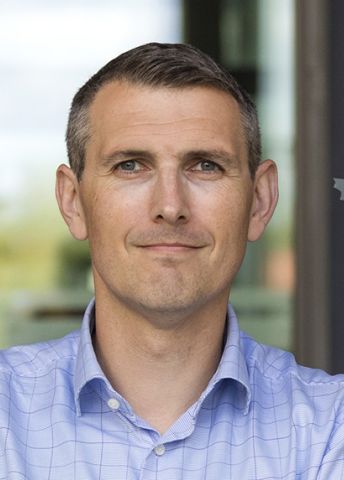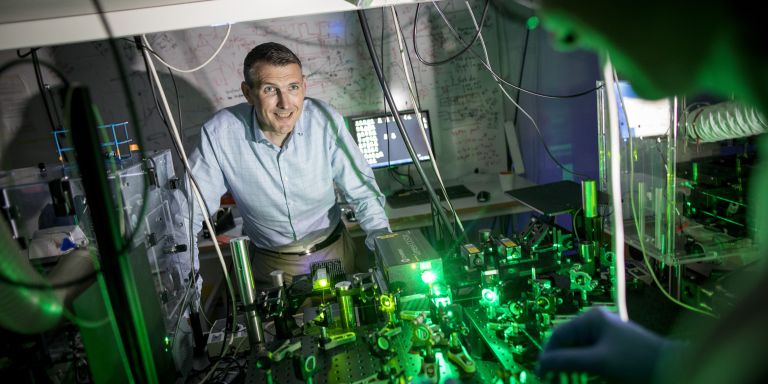
Johan Elf
Professor of Physical Biology
Wallenberg Scholar
Institution:
Uppsala University
Research field:
How biochemical processes work in living cells


Wallenberg Scholar
Institution:
Uppsala University
Research field:
How biochemical processes work in living cells
But his work as a Wallenberg Academy Fellow has focused on how molecules find each other in the cell, a topic he will continue to research as a Wallenberg Scholar. Part of the question involves the search problem faced by certain proteins, known as transcription factors, when they have to find their target among five million DNA base pairs to turn the right genes on or off. It sounds like an impossible task, like finding a needle in a haystack, yet they almost always succeed. But if the right genes are not activated or deactivated, functions may be put out of action and disease may occur.
“We have continued to study this in more detail, particularly chemical processes occurring when the protein scans DNA.”
In summer 2020, he and his colleagues published an article in Nature describing how a transcription factor rotates around the DNA helix as it searches for the right gene.
“We’re now trying to use the transcription factors to extrapolate the generic features for finding the right sequences in the DNA, how a molecule decides whether it is in the right place or whether it should move on, and how long it takes.”
The research team has also examined the search problem for CRISPR-Cas9, the molecular machinery sometimes known as “molecular scissors”, to understand how it searches for the place where it is supposed to cut the DNA. Cutting in the right place is critically important if this technology should be used for therapeutic purposes.
“It is to some extent a different process. Cas9 can be programmed with RNA to search for (almost) any sequence at all. But it takes much longer, because instead of gliding on the surface of the DNA, Cas9 has to separate the DNA strands so it can compare the base pairs with the RNA.”
Another search problem under the spotlight is that of double-strand breaks and how they are repaired in the cells – a process known as “homologous recombination”.
“The cell can use the other copy of the chromosome as a template for mending the break. But then a new, seemingly insoluble, search problem arises: how does the cell find the DNA copy? After all, it has to drag along the broken ends, unravel the DNA helix, and compare with the base sequence – and do it quickly.”
Elf and his team have recently worked out how it is done by studying E. coli.
“We have just submitted a manuscript. It’s a highly efficient process. The recombination machinery can do in eight minutes what it takes Cas9 six hours to do. We think the mechanism is the same in all organisms since the proteins involved are also found in our cells.”
Among other things, the findings may lead to new, more rational genetic modification methods, and also have a bearing on cancer treatment, since cancer is often linked to unrepaired damaged DNA.
To study these processes, the team is developing new measurement methods that allow them to study individual molecules in living cells. The methods are being adapted to suit the specific issues, but almost always include a combination of techniques from different branches of science, such as genetics, optics and microfluidics.
Previously, the team performed measurements on one strain of bacteria at a time, but recently they have managed to scale up the methods so they can study a whole library of bacterial strains at the same time.
“For instance, we can simultaneously follow the DNA replication process in detail in hundreds of genetically different bacterial strains. The method is a powerful one, but generates a huge amount of data – around one terabyte of image data has to be analyzed for each experiment. This alone has made it necessary to develop new AI methods.”
The next step will be to use the methods to determine the structure of the chromosome in a living cell.
“One of the strengths of the Scholar grant is that it allows me as a researcher to choose to work on what I find most relevant, and change the agenda if I stumble on something new.”
Almost by chance, the approach has also resulted in the creation of a company with over 40 employees.
“It wasn’t our intention that the methods would have a practical application – it came as a surprise. We normally stay strictly within the confines of basic research, but using the microfluidics and image analysis tools we had developed, we were also able to very quickly say which antibiotic would work best and whether or not an infection is resistant to antibiotics.”
Using traditional methods, it takes up to two days to obtain an answer to that question, but the new method offers a much shorter wait. They can already test for antibiotic resistance in an infection of the urinary tract, and get an answer in 30 minutes.
First and foremost, Elf is interested in the fundamental processes in the cell, particularly where established scientific models of those processes are not consistent with his observations. One problem he has been interested in for several years, but where the pieces have not really fallen into place, concerns DNA replication in bacterial cells.
“Since the 1960s there has been an established model for overlapping replication cycles. Despite performing a huge number of measurements, we haven’t managed to see them, though we should have. Now we’re trying to find out whether our tools are too blunt or whether the science has been wrong for fifty years.”
Elf had already decided he would be a researcher during his studies at high school in Motala, southern Sweden.
“I find it exciting. It gives me a kick to arrive at a potential explanation, even if it later turns out to be wrong. It’s a wonderful job – free, and incredibly privileged, but it also brings with it a great responsibility to do important work as well as possible, or preferably better.”
Alongside his research Elf is also engaged in research politics. He is on the board of Uppsala University and is also a member of the Royal Swedish Academy of Sciences research politics committee.
Text Carina Dahlberg
Translation Maxwell Arding
Photo Mikael Wallerstedt, Faktabruket